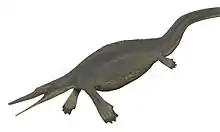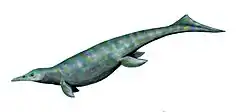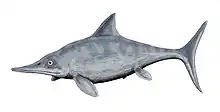Baptanodon
Baptanodon is an ichthyosaur of the Late Jurassic period (160-156 million years ago), named for its extremely large eyes. It had a graceful 6 m (19.5 ft) long dolphin-shaped body, and its almost toothless jaw was well adapted for catching squid. Major fossil finds of this genus have been recorded in North America. The type species, B. natans, was originally named as a species of Ophthalmosaurus in 1879.[1]
| Baptanodon | |
|---|---|
 | |
| Scientific classification | |
| Kingdom: | Animalia |
| Phylum: | Chordata |
| Class: | Reptilia |
| Order: | †Ichthyosauria |
| Family: | †Ophthalmosauridae |
| Subfamily: | †Ophthalmosaurinae |
| Genus: | †Baptanodon Marsh, 1880 |
| Type species | |
| †Baptanodon natans Marsh, 1880 | |
| Synonyms | |
| |
Discovery and species
Baptanodon was named as a species of Ophthalmosaurus in 1879[1] and was moved to its own genus Baptanodon in 1880.[2] Baptanodon was considered a junior synonym of Ophthalmosaurus by Maisch & Matzke (2000).[3] However, cladistic analyses published in the 2010s indicate that Baptanodon is not congeneric with Ophthalmosaurus icenicus.[4][5][6]
Classification
The cladogram below follows Fischer et al. 2012.[5]
| Thunnosauria |
| ||||||||||||||||||||||||||||||||||||||||||||||||||||||||||||||||||||||||||||||||||||||||||
Palaeobiology
Fossils of Baptanodon have been found in the Oxfordian-age Sundance Formation of Wyoming, which also has yielded fossils of the cryptoclidids Tatenectes and Pantosaurus, and the pliosaurid Megalneusaurus.[2][8]
References
- O. C. Marsh. 1879. A new order of extinct reptiles (Sauranodonta), from the Jurassic Formation of the Rocky Mountains. The American Journal of Science and Arts, series 3
- Marsh, O. C., 1880, Note on Sauranodon: American Journal of Science, 3rd series, v. 19, n. 4, p. 491.
- Maisch MW, Matzke AT. 2000. The Ichthyosauria. Stuttgarter Beiträge zur Naturkunde Serie B (Geologie und Paläontologie) 298: 1-159.
- Patrick S. Druckenmiller and Erin E. Maxwell (2010). "A new Lower Cretaceous (lower Albian) ichthyosaur genus from the Clearwater Formation, Alberta, Canada". Canadian Journal of Earth Sciences. 47 (8): 1037–1053. Bibcode:2010CaJES..47.1037D. doi:10.1139/E10-028.CS1 maint: uses authors parameter (link)
- Valentin Fischer; et al. (2012). "New Ophthalmosaurid Ichthyosaurs from the European Lower Cretaceous Demonstrate Extensive Ichthyosaur Survival across the Jurassic–Cretaceous Boundary". PLoS ONE. 7 (1): e29234. Bibcode:2012PLoSO...729234F. doi:10.1371/journal.pone.0029234. PMC 3250416. PMID 22235274.
- Ilaria Paparella; Erin E. Maxwell; Angelo Cipriani; Scilla Roncacè; Michael W. Caldwell (2017). "The first ophthalmosaurid ichthyosaur from the Upper Jurassic of the Umbrian–Marchean Apennines (Marche, Central Italy)". Geological Magazine. 154 (4): 837–858. doi:10.1017/S0016756816000455.
- Arkhangel’sky, M. S., 1998, On the Ichthyosaurian Genus Platypterygius: Palaeontological Journal, v. 32, n. 6, p. 611-615.
- Marsh, O. C., 1895, The Reptilia of the Baptanodon Beds: American Journal of Science, 3rd series, v. 34., n. 299, p. 405-406.




